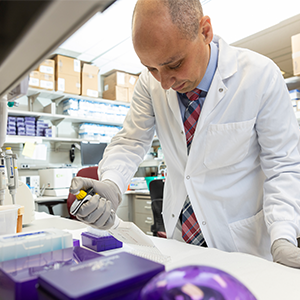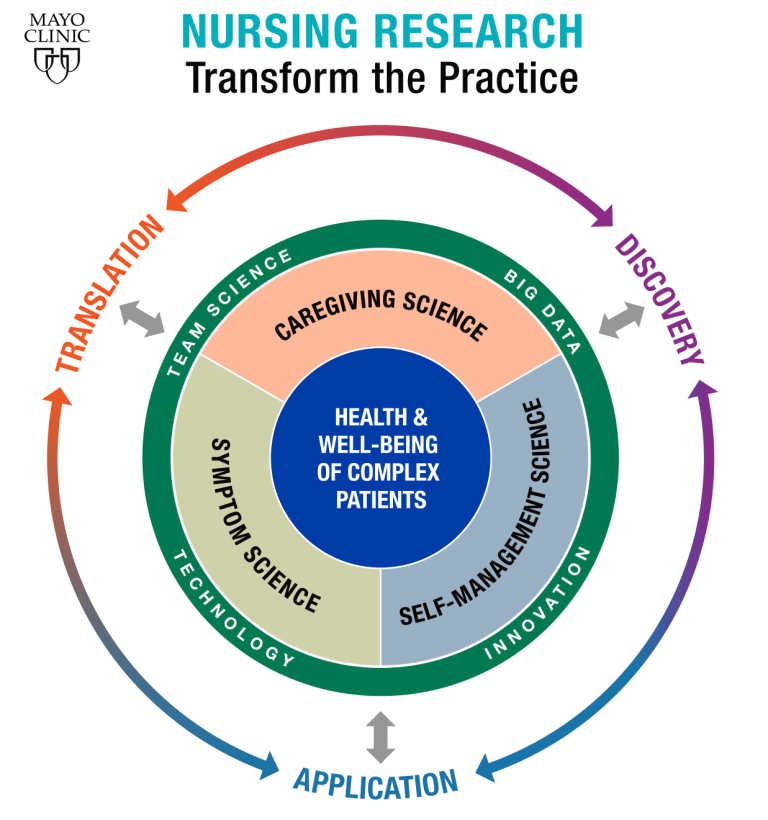
This is a story about genes and family.
"My father had polycystic kidney disease," says Gene Okun. "We didn't know it at the time when we were young. Lo and behold, it came, and he ended up on dialysis."
Gene has his father's genes. Some of them are good.
"I was a bodybuilder for many years and a powerlifter," he says.
Some of his father's genes are not so good.
"The long and short of it is I inherited [polycystic kidney disease] from my father," Gene says. "[I] didn't know I had it [when I was younger]."
"The progression really was slow, and you don't really notice it every day," he says. "But it creates a lot of difficulties in my life."
Difficult is how life is when you have polycystic kidney disease.
"What happens is the patients who have this genetic defect or mutation will start forming kidney cysts," says Dr. Fouad Chebib, a Mayo Clinic nephrologist who is part of a team researching better treatments for polycystic kidney disease. "Those are fluid-filled sacs in the kidney. So as they are growing, the kidney starts to fill with fluids and kind of grow and grow. They have multiple ... cysts, and that damages the kidney, leading to kidney failure."
"In my situation, the average kidney is supposed to be the size of your fist," Gene explains.
But Gene's are quite a bit bigger. In fact, his kidneys might be the largest kidneys ever recorded.
"We're not quite sure how big because I can't do a full scan properly with dye," Gene says. "But the guess is that they're over 10 pounds each or more."
"It really kind of affects everything in my life."
Watch: Man with world's largest kidneys undergoes complicated transplant surgery at Mayo Clinic.
Journalists: Broadcast-quality video pkg (5:56) is in the downloads at the end of this post. Please ‘Courtesy: Mayo Clinic News Network.’ Read the script.
Gene says his oversized kidneys make him look pregnant. And even though his stomach looks huge, he isn't able to eat much because his kidneys leave little space for other organs such as his stomach to expand. The giant kidneys also make simple tasks like putting on his shoes difficult. They also can make it hard for him to find a comfortable sleeping position.
And the larger Gene's kidneys get, the worse they function.
And though he has his father's genes, Gene didn't want to end up like his father.
"[I] chose a different path," he says.
Instead of letting himself deteriorate until he had to go on dialysis, he decided to seek a kidney transplant. But for Gene and his massive kidneys, that was no small task.
"The doctors that I had gone to before, the surgeons had all given me different opinions on how they thought they were going to do this thing," Gene says.
Not satisfied with what he was hearing, Gene listened to someone who suggested he go see Dr. Mikel Prieto, a kidney transplant surgeon at Mayo Clinic in Rochester, Minnesota.
"We offered him to have the opportunity to have not only a kidney transplant, but at the same time take those large bothersome kidneys out," Dr. Prieto says.
Though Dr. Prieto acknowledged that Gene's kidneys were likely the biggest kidneys ever operated on, he had successfully performed the same operation several times before and was confident he could do the same for Gene.
"For me, that was a big deal because I had an uneasy feeling all the way along with where am I gonna do this," he says. "And who's gonna do it? And I didn't have comfort with either of those organizations, which are very good and world-renowned. But it wasn't until I came here to ... Mayo [Clinic] until I felt very good about this is where I'm gonna have the surgery done, and this is who's gonna do the surgery."
But Gene still needed a healthy kidney.
As a resident of California, he knew the average wait time for a kidney from a deceased donor was roughly seven to nine years. But at the rate his kidneys were deteriorating, he would be on dialysis long before that.
So he took a unique approach to finding a donor.
"The idea was to create a little bit of humor, and ... take a serious ... situation and put a little humor on it that would get people to look at it," he says.
The result was a series of comedic videos tracking the challenges of what he called "Gene's Big Dumb Kidneys."
And it worked.
"It's very moving to meet people and talk to people that they don't even know you, but they're willing to give a kidney," Gene says. "And not for money. Not for anything, but just because they have a good heart."
In the end, though, it was someone very close to Gene who ended up being the best match for kidney donation.
"I can only say it's probably God's hand because I looked for a long time," Gene explains. "And he's an amazing guy, an amazing individual, and a very unselfish person to do this for me."
Bill McNeese, a business colleague and one of Gene's closest friends ended up being almost a perfect match. But testing showed McNeese needed to drop some weight if he was going to be able to donate his kidney.
"I was a prime candidate for [a] heart attack," McNeese says. "So it motivated me to go back to the gym, which I did."
Luckily for McNeese, the guy hoping to get his kidney happened to be a former world-class bodybuilder.
"I helped him a little bit with some good diet tips and really kind of gave him an idea of how much cardio he would need to do to lose weight," Gene says.
A few months and 50 pounds later, two best friends lie in neighboring beds preparing to go into surgery.
And after McNeese dropped 50 pounds to get to this moment, both men wonder how many pounds lighter Gene will be when he comes out of surgery.
"I'm guessing it's going to be around 34 or 35 pounds," Gene says. "And they're going to add his pounds back in. There' a pool online right now. We've got – I don't know – I think over 100 guesses so far."
Before being taken back for surgery, Gene is thankful for his friend's sacrifice and ready to get the surgery over with.
"Say goodbye to Big and Dumb," he says, using the nicknames he has given to his giant kidneys.
Meanwhile, McNeese is reflective about his role in changing Gene's life.
"It's an arduous process, but probably the most worthwhile things I've ever done," he says.
Soon after, Gene is rolled away to the operating room to begin the extensive and tedious process of removing both of his diseased kidneys, and replacing them with one of McNeese's healthy ones.
For 12 hours, Dr. Prieto felt his way around the inside of Gene's abdomen.
"With a laparoscopic procedure, we have freed [the kidneys] out from all the surrounding structures," Dr. Prieto explains. "We have stapled across the artery. We have stapled across the vein. So they are free-floating inside. And at this point, they need to come out, and for them to come out, we need to drain a lot of the fluid out. And sometimes that's kind of a little bit of ... an aggressive approach because those kidneys, they are hard to get out. And then only by poking a lot of cysts – most of the time I do it with [my] hands – I manage to get them out."
It takes more than six hours to get both of Gene's kidneys drained and removed.
Then Dr. Prieto moves to a second operating room close by where his team has begun removing McNeese's healthy kidney. Once they have it out, they work quickly to get it prepared to transplant into Gene. When it's ready, they place it in a bowl and roll it on a cart over to Gene's operating room, where he remains under anesthesia.
It takes several more hours to get the healthy kidney properly transplanted into Gene.
Two days later, sitting in a hospital room, Gene reflects on the first moments after he woke up after surgery.
"Just opening my eyes after that kind of thing was amazing," he says. "I felt like I'm alive. And then the next thing was I have a new kidney in me and my stomach was completely flat. I could see my feet, and I was just blown away."
Because of how huge his kidneys had gotten, it had been a long time since Gene could see his feet. But with the kidneys removed, he was getting a new perspective on life and his body.
"I'm feeling amazing," he says. "I can feel it. I feel like I have more energy. And, I mean, this is only two days out of this long, 12-hour surgery. And I've been walking up and down the halls. I can't tell you how good it feels. It's life-changing."
He's emotional as he thanks his friend, Bill McNeese, for giving him this life-changing gift.
"Knowing that I'm not going to be on dialysis is just a very big blessing," Gene says. "And, obviously, my hero made it possible.
But McNeese is only one of Gene's two heroes. The other is Dr. Prieto.
"One surgery, one day," Gene says. "Two big kidneys out, one kidney in. Same guy doing the surgery. That's a superhero right there."
Dr. Prieto is equally impressed by the resilience of a patient who might have had the biggest kidneys ever.
How big?
"I think we had on the ... suction canisters about 19 liters of fluid, and that doesn't include all the stuff we took out, like through the wound and so forth," Dr. Prieto says "So they were very large."
So after removing 19 liters of fluid and the actual kidneys, you might wonder who won the pool on how much weight Gene would lose in the surgery.
"Believe it or not, Billy won the weight bet," Gene says, pointing to McNeese.
"I actually weighed in this morning at 236 from 286. So 50 pounds came off," Gene says. "And I'm actually holding water from the fluids they've been pumping into me."
This is a story about Genes and family.
"It all starts from somebody stepping forward and saying they're going to save a life," Gene says. "And, selfishly, I'm grateful for that. I love you, buddy."
"I love you too, bro," McNeese says.







